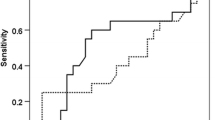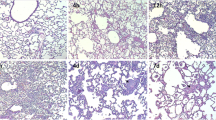Abstract
With the purpose of studying the role of proteinases in the development of ARDS, plasma levels of immunoreactive trypsin (IRT) and amylase were measured in 43 intensive care patients at risk of developing ARDS (22 polytrauma, seven abdominal surgery, four burns, two DIC and eight pancreatitis). Twenty four of these 43 patients developed ARDS and 31 presented abnormal IRT values (above 70 μg/L). Twenty-one of these 31 patients had ARDS; a significant correlation thus appeared between ARDS and abnormal IRT values. In nine patients, IRT values were higher than 800 μg/L and remained high for 3 to 4 days. A statistically significant correlation also appeared between abnormal IRT and septic phenomena: 20 patients with high IRT values presented septic problems. When IRT values were high, amylase values were often also abnormal: 12 of 23 patients with high IRT had abnormal amylase levels (the eight patients with documented pancreatitis were excluded); no other clinical signs or symptoms of pancreatitis were present in these patients. IRT could be one of the mediators of ARDS in septic patients. It is not clear that the pancreas is the origin of IRT in all cases.
Similar content being viewed by others
References
Asbaugh DG, Bigelow DB, Petty TL (1967) Acute respiratory distress in adults. Lancet 2:319
Blaisdell FW, Lewis FR (1977) Respiratory distress syndrome of shock and trauma: Post-traumatic respiratory failure. In: Ebert PA (ed) Major problems in clinical surgery, XXI. WB Saunders, Philadelphia, p 84
Brigham KL (1982) Mechanisms of lung injury. Clin Chest Med 3(1):9
Craddock PR, Hammerschmidt DE, Moldow CF et al. (1979) Granulocyte aggregation as a manifestation of membrane interactions with complement: possible role in leukocyte margination, microvascular occlusion and endothelial damage. Semin Hematol 16:140
Geokas MC, Largman C, Brodrick JW, Johnson JH (1979) Determination of human pancreatic cationic trypsinogen in serum by radioimmunoassay. Am J Physiol 236:E77
Haverback BJ, Dyce B, Bundy HF et al. (1962) Protein binding of pancreatic proteolytic enzymes. J Clin Invest 41:972
Hosea S, Brown E, Hammer C et al. (1980) Role of complement activation in a model of adult respiratory distress syndrome. J Clin Invest 66:375
Jacob HS, Moldow CF, Flynn PJ et al. (1982) Therapeutic ramifications of the interaction of complement, granulocytes and platelets in the production of acute lung injury. Ann NY Acad Sci 77:498
Janoff A, White R, Carp H et al. (1979) Lung injury induced by leukocytic proteases. Am J Pathol 97:111
Kugimiya T, Inokuma S, Yamaguchi K, Suwa K, Miyamoto T (1982) Acquired aberrant expression of serum α1-antitrypsin in postoperative respiratory distress. VIth European Congress of Anesthesiology, London, 8–15 September
Lasson A, Ohlsson K (1982) An in vitro study of the influence of plasma protease inhibitors and aprotinin on trypsin-induced C3 cleavage in human serum. Bioch Biophys Acta 709:227
Lee CT, Fein AM, Lippmann M, Holtzman H, Kimbel P, Weinbaum G (1981) Elastolytic activity in pulmonary lavage fluid from patients with adult respiratory distress syndrome. N Engl J Med 304:192
Mc Donald JA, Baum BJ, Rosenberg DM et al. (1979) Destruction of a major extracellular adhesive glycoprotein (fibronectin) of human fibroblasts by neutral proteases from polymorphonuclear leukocyte granules. Lab Invest 40:350
Mc Guire WA, Spragg RG, Cohen AB et al. (1982) Studies on the pathogenesis of the adult respiratory distress syndrome. J Clin Invest 69:543
Malvano R, Marchisio M, Massaglia A et al. (1980) Radioimmunoassay of trypsinlike substance in human serum. Scand J Gastroenterol 15 (suppl 62):3
Rinaldo JE, Rogers M (1982) Adult respiratory distress syndrome. N Engl J Med 15:900
Sacks T, Moldow CF, Craddock PR et al. (1978) Oxygen radicals mediate endothelial cell damage by complement stimulated granulocytes: an in vitro model of immune vascular damage. J Clin Invest 61:1161
Staub NC (1978) Pulmonary edema due to increased microvascular permeability to fluid and protein. Circ Res 43:143
Wetsel RA, Kolb WP (1982) Complement-independent activation of the fifth component (C5) of human complment: limited trypsin digestion resulting in the expresion of biologic activity. J Immunol 128 (5):2209
Witte J, Jochum M, Scherer R, Schramm W, Hochstrasser K, Fritz H (1982) Disturbance of selected plasma proteins in hyperdynamic septic shock. Intensive Care Med 8:215
Zapol W, Snider MT, Hill JD et al. (1979) Extracorporeal membrane oxygenation in severe acute respiratory failure. JAMA 242(20):2193
Author information
Authors and Affiliations
Rights and permissions
About this article
Cite this article
Deby-Dupont, G., Maas, M., Pincemail, J. et al. Immunoreactive trypsin in the adult respiratory distress syndrome. Intensive Care Med 10, 7–12 (1984). https://doi.org/10.1007/BF00258062
Accepted:
Issue Date:
DOI: https://doi.org/10.1007/BF00258062




